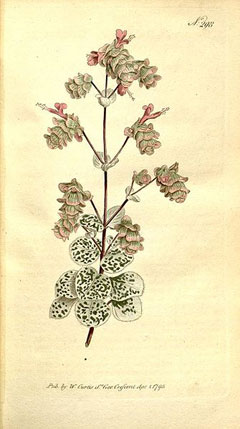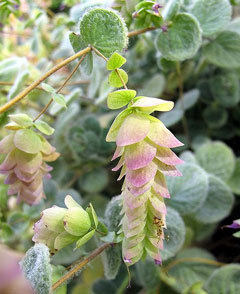 |
|
http://commons.wikimedia.org/wiki/File:Origanum_dictamnus.jpg |
 |
| http://commons.wikimedia.org/wiki/User:HelenaH |
Translate this page:
Summary
Bloom Color: Pink. Main Bloom Time: Late summer, Mid summer. Form: Rounded.
Physical Characteristics

 Origanum dictamnus is a PERENNIAL growing to 0.2 m (0ft 8in) by 0.4 m (1ft 4in) at a medium rate.
Origanum dictamnus is a PERENNIAL growing to 0.2 m (0ft 8in) by 0.4 m (1ft 4in) at a medium rate.
See above for USDA hardiness. It is hardy to UK zone 7. It is in flower from June to August. The species is hermaphrodite (has both male and female organs) and is pollinated by Bees.
Suitable for: light (sandy), medium (loamy) and heavy (clay) soils and prefers well-drained soil. Suitable pH: mildly acid, neutral and basic (mildly alkaline) soils and can grow in very alkaline soils.
It cannot grow in the shade. It prefers dry or moist soil.
UK Hardiness Map
US Hardiness Map
Synonyms
Amaracus dictamnus. (L.)Benth.
Plant Habitats
Cultivated Beds;
Edible Uses
Edible Parts: Leaves
Edible Uses: Condiment Tea
The leaves are used for flavouring salads and vermouth[183, 238]. A pleasant aromatic flavour, especially when mixed with parsley, thyme, garlic, salt and pepper[183]. The flowering tops are dried and brewed into a herb tea[183, 238].
References More on Edible Uses
Medicinal Uses
Plants For A Future can not take any responsibility for any adverse effects from the use of plants. Always seek advice from a professional before using a plant medicinally.
Antirheumatic Oxytoxic Stomachic Vulnerary
The flowering plant has been used as an antirheumatic, oxytocic, stomachic and vulnerary[148], though these uses appear to be obsolete in modern herbalism[238]..
References More on Medicinal Uses
The Bookshop: Edible Plant Books
Our Latest books on Perennial Plants For Food Forests and Permaculture Gardens in paperback or digital formats.

Edible Tropical Plants
Food Forest Plants for Hotter Conditions: 250+ Plants For Tropical Food Forests & Permaculture Gardens.
More

Edible Temperate Plants
Plants for Your Food Forest: 500 Plants for Temperate Food Forests & Permaculture Gardens.
More

More Books
PFAF have eight books available in paperback and digital formats. Browse the shop for more information.
Shop Now
Other Uses
References More on Other Uses
Cultivation details
Landscape Uses:Border, Container. Requires a rather dry, warm, well-drained soil, but is not fussy as to soil type, thriving on chalk[1]. Prefers slightly alkaline conditions[1]. This species is not fully hardy in Britain according to one report[1] whilst another says that it is hardy to zone 7[200], which means that it can succeed outdoors in most parts of the country. It is, however, very susceptible to winter wet and so is more commonly grown under cover in this country[238]. Members of this genus are rarely if ever troubled by browsing deer[233]. Special Features:
Attractive foliage, Fragrant foliage, Suitable for dried flowers.
References Carbon Farming Information and Carbon Sequestration Information
Temperature Converter
Type a value in the Celsius field to convert the value to Fahrenheit:
Fahrenheit:
The PFAF Bookshop
Plants For A Future have a number of books available in paperback and digital form. Book titles include Edible Plants, Edible Perennials, Edible Trees,Edible Shrubs, Woodland Gardening, and Temperate Food Forest Plants. Our new book is Food Forest Plants For Hotter Conditions (Tropical and Sub-Tropical).
Shop Now
Plant Propagation
Seed - sow early spring in a greenhouse at 10 - 13°c and only just cover the seed. Germination usually takes place within 2 weeks. Prick out the seedlings into individual pots when they are large enough to handle and plant them out into their permanent positions in early summer. The seed can also be sown in situ in late spring. Division in March or October. Very easy, larger divisions can be planted out direct into their permanent positions. We have found that it is better to pot up the smaller divisions and grow them on in light shade in a cold frame until they are well established before planting them out in late spring or early summer. Basal cuttings of young barren shoots in June. Very easy. Harvest the shoots with plenty of underground stem when they are about 8 - 10cm above the ground. Pot them up into individual pots and keep them in light shade in a cold frame or greenhouse until they are rooting well. Plant them out in the summer.
Other Names
If available other names are mentioned here
Native Range
EUROPE: Greece (Kríti)
Weed Potential
Right plant wrong place. We are currently updating this section.
Please note that a plant may be invasive in one area but may not in your area so it’s worth checking.
Conservation Status
IUCN Red List of Threatened Plants Status :

Growth: S = slow M = medium F = fast. Soil: L = light (sandy) M = medium H = heavy (clay). pH: A = acid N = neutral B = basic (alkaline). Shade: F = full shade S = semi-shade N = no shade. Moisture: D = dry M = Moist We = wet Wa = water.
Expert comment
Author
L.
Botanical References
50200
Links / References
For a list of references used on this page please go here
Readers comment